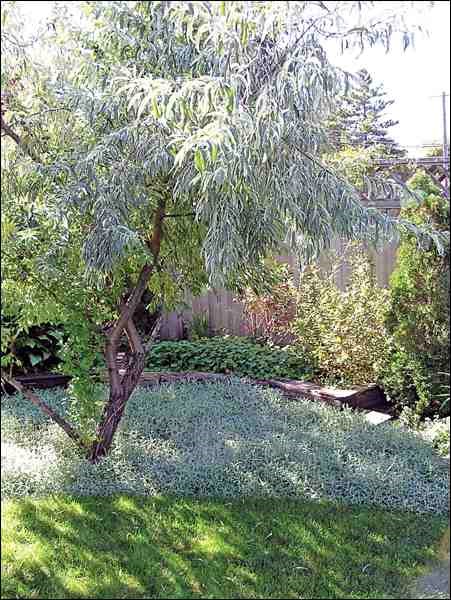Trees and shrubs with silver or grey foliage are attractive on their own but they really stand out when placed next to shrubs with purple-red foliage such as many of the barberries and ninebarks, not to mention Schubert chokecherry.
Two excellent silver-leaved, hardy woody perennials are Russian olive and wolfwillow, both members of the genus Elaeagnus. Both have attractive silver foliage, small silver berries and fragrant but inconspicuous flowers.
Russian olive (Elaeagnus angustifolia) is to dry areas what willows are to wet sites. Both have a large and billowy "willowy" appearance. The species name, angustifolia, means narrow leafed. Native to Europe and Asia, Russian olive is a graceful, fine textured tree, ranging in height from 4.5 to 7.5 metres. Leaves, twigs, flowers and fruit are all covered in minute grey scales, giving it a silvery appearance. The long, narrow leaves are retained through most of the winter, lending it a permanent "hoarfrosted" look. The inconspicuous yellow and silver flowers, borne in early June, are highly fragrant and are followed by inedible olive-like fruit. Thorny and non-thorny forms are available.
Russian olives do best in full sun in well-drained soils. They are drought- and salt tolerant but will not tolerate flooding or poor drainage. Some cultivars may suffer winter injury. These trees are used as specimen or shade trees, in screen plantings and in shelterbelts. The silver foliage contrasts well with evergreens and shrubs with red and purple foliage. Birds consume the fruit.
Wolfwillow (E. commutata) is native to the prairies and casts its sweet scent along fence lines in May, bringing nostalgic memories of walking to school to those who grew up in rural areas. An upright and sometimes leggy shrub of up to 2.5 metres, it suckers freely, soon forming thickets. Place it with care. It can be extremely "well-behaved" for 6 or 7 years and then dozens of unwanted suckers will emerge one spring as though by magic. On farms and acreages, a saline slough or a septic field is ideal. Little else will grow in these environments and there it can spread freely. The branches and leaves are covered with silvery scales. The fragrant, tubular, four-petalled flowers are inconspicuous, silver outside and yellow within. The small, silver fruit is dry and mealy.
Among the cultivars is Silverscape, a sterile hybrid of Russian olive and wolfwillow of only 1.8 metres in height and with less suckering than wolfwillow.
'Zempin' is an improved selection, widely available in Europe but much less so here in Canada. About 3.5 to 4.5 metres in height, it has very dark (almost black) branches and intense, contrasting silver foliage. Be warned: it suckers freely.
Wolfwillow does best in full sun in a variety of soils. It is used for wildlife plantings, naturalization, reclamation and on banks and slopes to control erosion. It provides food and cover for birds and is a bee nectar source.
Note: if your landscape is small, look for a wolfwillow that has been grafted onto Russian olive rootstock to prevent suckering.
Two other large shrubs with grey foliage are sea buckthorn (Hippophae rhamnoides) and buffaloberry (Sheperdia argentea), another Prairie native. Neither is recommended for smaller urban landscapes because of their size, thorny nature, and tendency to sucker.
In their favour, they both are extremely drought-tolerant, salt tolerant and produce fruit. Although intensely labour intensive to pick and remove from stems, the fruit of sea buckthorn makes a lovely jam, similar in taste to an apricot liqueur. The red berries of buffaloberry were once widely used for pemmican. Both shrubs provide food and cover for birds.
Williams is the author of the new and revised Creating the Prairie Xeriscape. In her latest book, Saskatoon Forestry Farm Park & Zoo: A Photographic History, she tells of the history of an institution and the personal stories of the people who made an important impact on Prairie agriculture.
- This column is provided courtesy of the Saskatchewan Perennial Society (www.saskperennial.ca; [email protected]). Check out our Bulletin Board or Calendar for upcoming garden information sessions.




